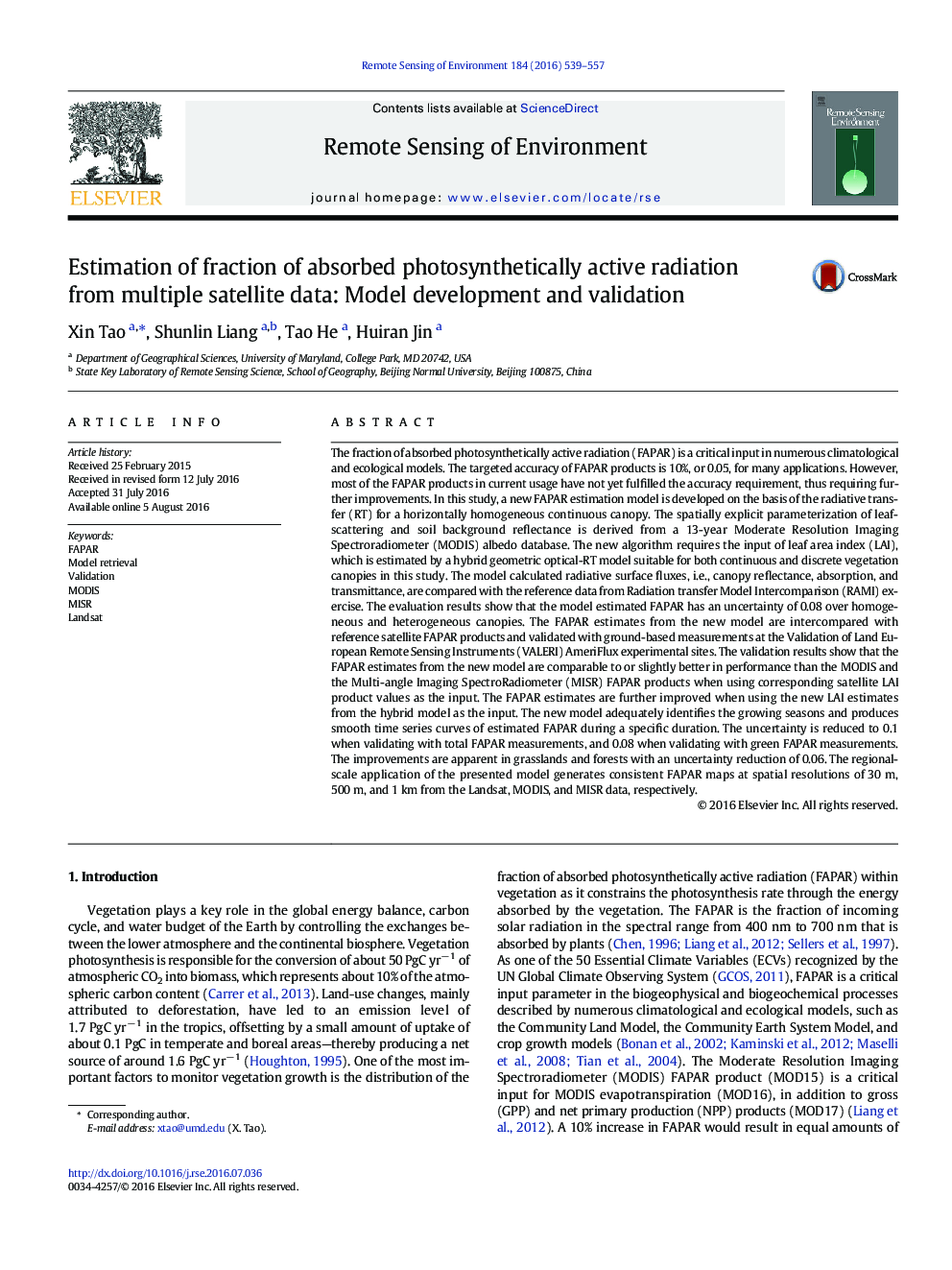| کد مقاله | کد نشریه | سال انتشار | مقاله انگلیسی | نسخه تمام متن |
|---|---|---|---|---|
| 6345260 | 1621216 | 2016 | 19 صفحه PDF | دانلود رایگان |
عنوان انگلیسی مقاله ISI
Estimation of fraction of absorbed photosynthetically active radiation from multiple satellite data: Model development and validation
ترجمه فارسی عنوان
تخمین کسر جذب فعال تابش فعال فتوسنتزی از داده های چند ماهواره ای: توسعه مدل و اعتبار سنجی
دانلود مقاله + سفارش ترجمه
دانلود مقاله ISI انگلیسی
رایگان برای ایرانیان
کلمات کلیدی
موضوعات مرتبط
مهندسی و علوم پایه
علوم زمین و سیارات
کامپیوتر در علوم زمین
چکیده انگلیسی
The fraction of absorbed photosynthetically active radiation (FAPAR) is a critical input in numerous climatological and ecological models. The targeted accuracy of FAPAR products is 10%, or 0.05, for many applications. However, most of the FAPAR products in current usage have not yet fulfilled the accuracy requirement, thus requiring further improvements. In this study, a new FAPAR estimation model is developed on the basis of the radiative transfer (RT) for a horizontally homogeneous continuous canopy. The spatially explicit parameterization of leaf-scattering and soil background reflectance is derived from a 13-year Moderate Resolution Imaging Spectroradiometer (MODIS) albedo database. The new algorithm requires the input of leaf area index (LAI), which is estimated by a hybrid geometric optical-RT model suitable for both continuous and discrete vegetation canopies in this study. The model calculated radiative surface fluxes, i.e., canopy reflectance, absorption, and transmittance, are compared with the reference data from Radiation transfer Model Intercomparison (RAMI) exercise. The evaluation results show that the model estimated FAPAR has an uncertainty of 0.08 over homogeneous and heterogeneous canopies. The FAPAR estimates from the new model are intercompared with reference satellite FAPAR products and validated with ground-based measurements at the Validation of Land European Remote Sensing Instruments (VALERI) AmeriFlux experimental sites. The validation results show that the FAPAR estimates from the new model are comparable to or slightly better in performance than the MODIS and the Multi-angle Imaging SpectroRadiometer (MISR) FAPAR products when using corresponding satellite LAI product values as the input. The FAPAR estimates are further improved when using the new LAI estimates from the hybrid model as the input. The new model adequately identifies the growing seasons and produces smooth time series curves of estimated FAPAR during a specific duration. The uncertainty is reduced to 0.1 when validating with total FAPAR measurements, and 0.08 when validating with green FAPAR measurements. The improvements are apparent in grasslands and forests with an uncertainty reduction of 0.06. The regional-scale application of the presented model generates consistent FAPAR maps at spatial resolutions of 30Â m, 500Â m, and 1Â km from the Landsat, MODIS, and MISR data, respectively.
ناشر
Database: Elsevier - ScienceDirect (ساینس دایرکت)
Journal: Remote Sensing of Environment - Volume 184, October 2016, Pages 539-557
Journal: Remote Sensing of Environment - Volume 184, October 2016, Pages 539-557
نویسندگان
Xin Tao, Shunlin Liang, Tao He, Huiran Jin,
